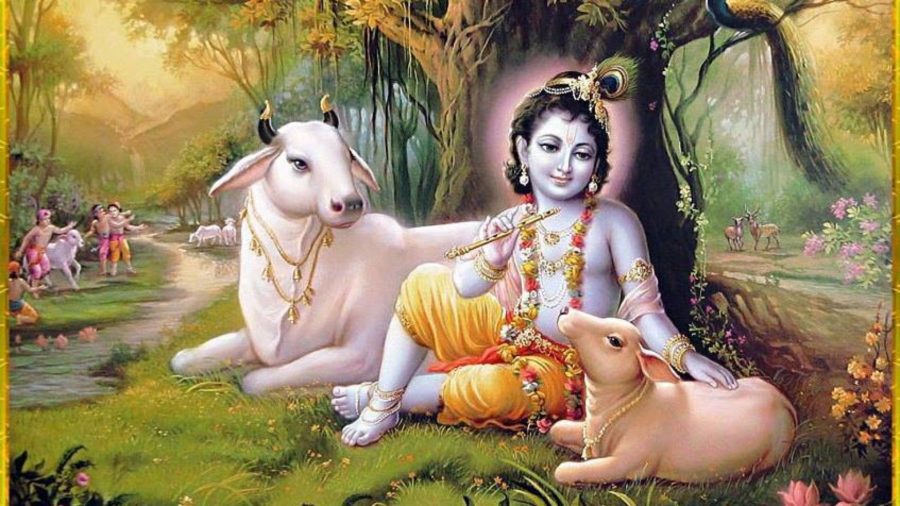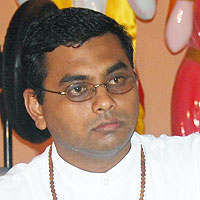Bhagavan Shri Krishna, the eighth major manifestation of Bhagavan Vishnu, fulfilled the promise that He espoused in Bhagavad Gita, through his many transcendental pastimes. Shri Krishna is considered a Vyuha avataar¸ one of the four transcendental emanations of the Divine that are instrumental in exercising cosmic functions and controlling the activities of living beings. In Treta Yug, they appeared as Shri Raam, Lakshman, Bharat and Shatrughna. In Dwaapar Yug, they revealed themselves as Shri Krishna, Balram, Pradumna and Anirudh. Shri Krishna is also considered a Purna avataar or a full manifestation of the Supreme. This form of Divinity performed His leelas on the world’s stage, protecting His devotees, creating ecstasy for them and, at the same time, destroying evil. Whether in Mathura, Gokula, Vraj or the battlefield of Kurukshetra, the many relationships He formed, the countless instances of revival of the human spirit, of repentance and reform, all revealed the glory of his manifestation and the lessons He left for the re-establishment of dharma in the world.
The Bhagavat Purana states that Shri Krishna was born at midnight in a prison cell in Mathura city as the eighth child of the imprisoned Devaki and Vasudev. He was carried across the River Yamuna to safety at Gokula village, where Yashoda and Nanda became his foster parents. Growing up in this agrarian village among the cows and cowherds, the child Krishna performed numerous leelas or transcendental pastimes, which created a state of ecstasy in the hearts of His devotees. At the same time, He used every opportunity to fulfil his mission of destroying unrighteousness and protecting his devotees. In keeping with His Divine plan, He brought an end to the evil reign of King Kans.
More than mere allegories, His activities on earth speak volumes of the lessons He projected for humanity’s uplift.
As Gopaal, Bhagavan Krishna is not only the protector of the cows, but also the One who shelters His devotees from being engulfed into the waters of sensuality and away from Divinity.
As Goverdhan Giridhaari, the One who uplifted the Goverdhan Mountain, Bhagavan taught man that it is only when the rising waters of sensuality are subdued, that the mountain of mental advancement, or enlightenment, can be lifted with the finger of quietude; then, one is led away from the path of materialism towards spirituality.
Dancing upon Kaalia Naag, Shri Krishna indicated to humans that the individual ego, portrayed by this deadly serpent, must be transformed to the Cosmic Ego, that is, to Divinity. Only then can actions be performed on the wings of vivek (power of discrimination) and vairaagya (spiritual dispassion) and propelled by the tail of bhakti (devotion).
Not merely is He Maakhanchor, the stealer of the maakhan (butter), but also Chittachor, the stealer of the devotee’s consciousness.
As Bansidharaa, the flute player, Bhagavan not only created ecstasy in the hearts of His devotees but He also taught profound lessons on karma yoga. The flute, made of bamboo, a non-fruit-bearing plant, is empty inside, when played. Like this musical instrument, Bhagavan taught that all our actions should be performed with purity and without expectation of rewards.
Shri Krishna represents the experience of ecstasy born of perfection. As Hindus celebrate Shri Krishna Janam Ashtami on September 2, 2018, it is a reminder that birth is poised on the doorway to liberation. By making a conscientious effort to embark on the process of spiritual evolution, the devotee is assured of divine manifestation within the heart.
By Paramacharya of Swaha, Pt. Hardeo Persad




P R Guruprasad
Thanks Pandidjee for your article that is simple in language and with deep spiritual meaning of Shree Krishna Avataar. Pranaams. KRISHNAARPANAMASTHU.